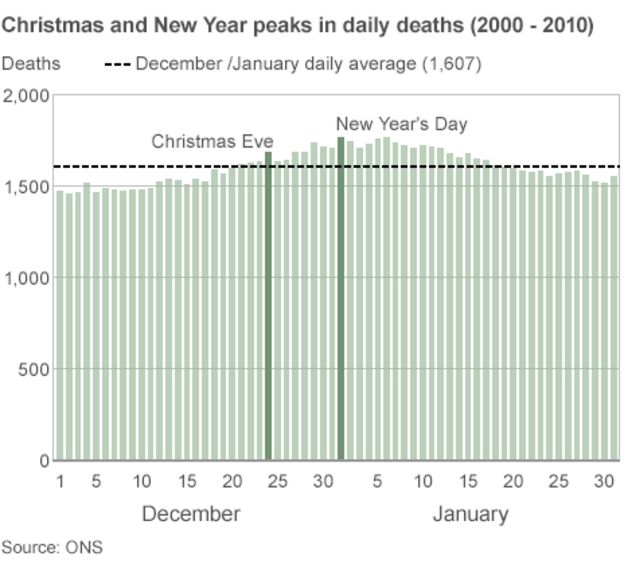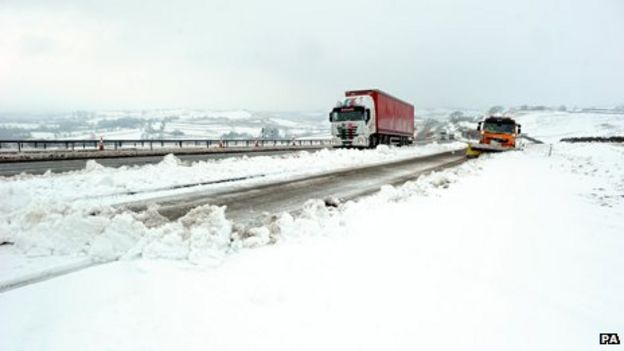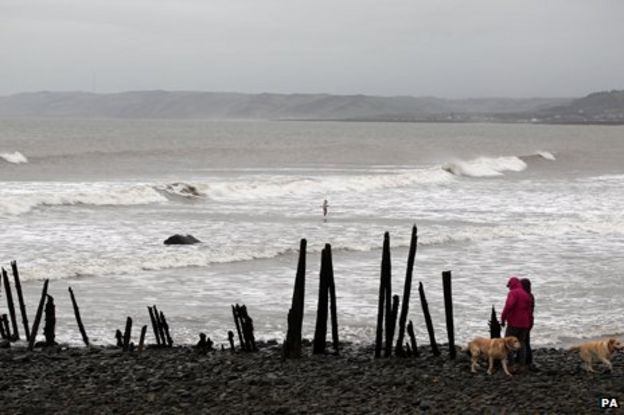The mystery of the most fatal week of the year

More British people die during the first full week of the year than at any other time. But perhaps surprisingly, it’s not as simple as blaming the cold weather.
The fact that more people die during the winter months probably won’t come as much of a surprise, but the reasons behind it might.
The chart below shows deaths by day during December and January in England and Wales. It shows a peak during the first full week of the year.

Figures from the National Records of Scotland show a similar pattern. Between 2008 and 2013 the annualised daily average death figure was 149 but this rose to 166 deaths per day for December and January. Similarly the annual reports of the registrar general for Northern Ireland show that the number of deaths during December and January is 10% higher than the annualised daily figure.
Nearly all countries in the world suffer from “excess winter deaths”, which is the difference between the number of deaths which occur in winter (December to March) and the average number of deaths during the preceding four months (August to November) and the subsequent four months (April to July).
Typically, there are 25,000-30,000 British excess deaths each year, which is about 15% higher than the background rate – that is, the annualised daily average rate – at which people die.
But that number can fluctuate a lot. Last winter – 2012-13 – saw over 31,000 excess deaths, 29% more than the winter before that.
The first few months of 2013 were bitterly cold – in fact it was the second coldest March on record. But the winter of 2009-10 was colder overall yet the number of excess winter deaths didn’t go up.
Indeed, there is no overall correlation between a cold winter and a rise in excess winter mortality.

“If we look at Scandinavian countries, which generally have much, much colder winters than we do, the number of excess deaths in those countries is much lower,” says Claudia Wells, head of mortality analysis at the Office for National Statistics.
“But if you look at warmer countries, like Portugal and Spain, their excess deaths are much higher.”
And just to complicate matters, having more excess deaths in Spain and Portugal doesn’t mean that their overall life expectancy is lower than that in Scandinavian countries – in fact the levels are very similar.
What is perhaps more surprising is that studies have also shown that winter deaths are not linked to socio-economic status.
“When you look at all-cause mortality you see a very clear correlation between the deprivation in an area and the mortality rate. You don’t see that when you look at excess deaths,” says Wells.
“We know that people in Kensington and Chelsea have a higher life expectancy than those living in Glasgow but there is no north-south divide for excess winter deaths.”
In fact the county with the highest levels of excess winter mortality in 2012 was relatively affluent West Sussex, where 48.3% more deaths occurred during winter than the rest of the year. By contrast, there were no excess winter deaths that year in Ceredigion where one in five people are in fuel poverty.

You might expect that influenza and colds are more common when the temperature is lower – that is, typically from December to March in northern hemisphere countries.
But that’s only partially true, says Rachel Vreeman, a global health researcher at Indiana University. There is evidence that the flu virus thrives in cold, dry air, but there is no such correlation when it comes to colds.
“Many of us think that when the weather is cold outside we’re going to be much more likely to get sick and that actually is not true at all,” says Vreeman.
“They test this by putting cold viruses right into people’s noses and then exposing them to very cold temperatures, having them wear warm clothing or not warm clothing, hats on or no hats, and they see no difference in how likely you are to get sick.”
All this makes the rise in the number of deaths a bit of a mystery. The final piece of the puzzle is to examine is whether people who are admitted to hospital over Christmas and New Year are more likely to die there.
In 2011 the research company Dr Foster carried out a study which showed there was a 10% spike in deaths when people were admitted to hospital at the weekend. Could the same thing be happening over the festive period?
“We know that the peak occupancy weeks are just before and after Christmas – you get a lull during Christmas and hospitals are much emptier because people understandably don’t want to go in during that time, but we do find that is also the period where mortality rates reach their peak,” says Roger Taylor, director of research at Dr Foster.

“Your risk of death over that period is much higher if you are unfortunate to be admitted to hospital.”
The latest figures available show that the highest number of deaths in hospital come in the first two weeks of January, where 4,300 deaths occur weekly – but that’s during a time when 80-90,000 people a week are coming to hospital.
In the last week of December, the number of deaths is lower at just over 4,000, but there are only 63,000 people coming in.
So it’s difficult to draw a definitive conclusion as to why more deaths occur in the winter months.
It would be foolish to say that cold weather doesn’t play a part, but it’s perhaps not as deadly as some might expect. But we can say that the cold weather does not discriminate between rich and poor and north and south.
See how your local hospital’s Accident and Emergency department is coping in England.
Follow @BBCNewsMagazine on Twitter and on Facebook



